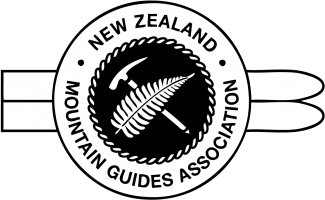NZMGA Alpine Trekking Guide Pathway
Alpine Trekking Guides are able to lead groups up to and through sub alpine walking terrain
Alpine Trekking Guides (ATGs) are able to lead trekking groups through non-technical trekking terrain - bush, subalpine, max grade I (new Mount Cook guide book grading) (where permanent or seasonal snow may be encountered) .
They may also be under supervision, guide technical trekking terrain, including “easy” glaciated neve trekking terrain, as well as suitable hard ice areas of lower glaciers.
The use of learnt, trained and assessed guiding techniques for such trekking, as per the NZMGA training and assessment scheme, could/will be used , and the basic skills of alpinism may be required. These include: use of ice axe, self arrest and crampon techniques
Some examples of non-technical trekking terrain (where, in general, rope guiding techniques would not be expected/ required) are:
- Three Pass trip (Arthurs Pass);
- Mueller Hut, Mt Wakefield, Mt Sebastopol, Sefton Biv (AMCNP)
- Cascade Saddle, up to Brewster Glacier, (Mount Aspiring National Park);
- Five Pass trip, Gertrude saddle (Mt Aspiring/Fiordland National park)
Technical Trekking Terrain
Technical Trekking Terrain is where the use of the rope is included in guiding techniques (expected), including “easy”* neve glacier terrain.
[* Non-technical glacier neve where a guide ropes up clients in glacier mode, and walks them up or down glacier expecting the terrain and route to be reasonably flat or low angle, route finding straightforward, not expecting to negotiate challenging bergschrunds or not traversing ice falls (yes, stopping to take photos of such features as picturesque seracs from a safe position) ]
It is expected that the guide enters into the intended spirit of these terrain guidelines to reflect their basic training and experience of such terrain. If their clients which to explore more technical or challenging terrain, a NZMGA climb or IFMGA guide should be engaged.
Technical trekking terrain requires supervision of ATG guides by either NZMGA Climb or IFMGA Guides
Activity providers may develop Site Specific SOPs for their terrain that encompasses technical trekking terrain.
The NZMGA very much supports a program where an ATG first works under direct supervision at a particular Technical Trekking Terrain site. Then, they may continue to work under the indirect supervision of an IFMGA Mountain or NZMGA Climb Guide.
Guidance for supervising/chief guides:
Examples of technical trekking terrain suitable for a well site trained and supervised NZMGA Alpine Trekking Guide is:
- Neve walk/trekking in summer from Tasman Glacier Kelman landing zone or upper neve landing zone, and trek down glacier to aircraft pick up.
- Ball Pass
- Pioneer Hut to Pioneer Pass
- Overnight to Plateau Hut and gentle neve walk onto Grand Plateau.
- Chancellor Dome
- Barron Saddle exit via lower glacier route
- Brewster Glacier to Mt Top Heavy
- Mtns Ruapehu, Tongariro, Taranaki
- Rabbit pass
Technical Terrain conditions for ATGs changes daily, seasonally and annually, significantly changing the hazards and technical difficulties. On the ground supervision and assessment of conditions is vital.

Logged Experience - Alpine Trekking
Entry onto the Alpine Trekking Guide Level 1 Course, requires:
Applicants must present for consideration to the Training Officer an Alpine…
Pre-Hospital Emergency Care Certificate (PHEC)
This advanced outdoor first aid qualification is recognised by New Zealand outdoor education and adventure tourism providers. During the 5-day…
Read MoreNew Zealand Certificate in Avalanche Risk Management - Level 5
This course provides the first level of professional training available, enabling participants to work in all sectors of the avalanche…
Read MoreAlpine Trekking Guide Pathway Application
To be allocated a place on the Alpine Trekking Guide Pathway, you must have met the following criteria:
Have completed the Logged Experience…
Entry into Training Phase
Snow and Ice Guide Training Course
This guides' training course is to take solid amateur mountaineering skills and knowledge and teach the candidate how to change/modify techniques…
Read MoreLevel 1 Alpine Trekking Assessment Course
This course assesses candidates on the Guiding skills necessary to perform as an Alpine Trekking Guide.
Candidates are expected to have full…
Assistant Guide Status
Alpine Trekking Guide Apprenticeship
To be allocated a place on a Alpine Trekking Guide Level 2 Course, you must have met the following criteria:
Have Assistant Alpine Trekking Guide…
Level 2 Alpine Trekking Assessment Course
Participants may be assessed on any topic of the Alpine Trekking Guide syllabus at any stage of the course and will be required to teach and…
Read More
